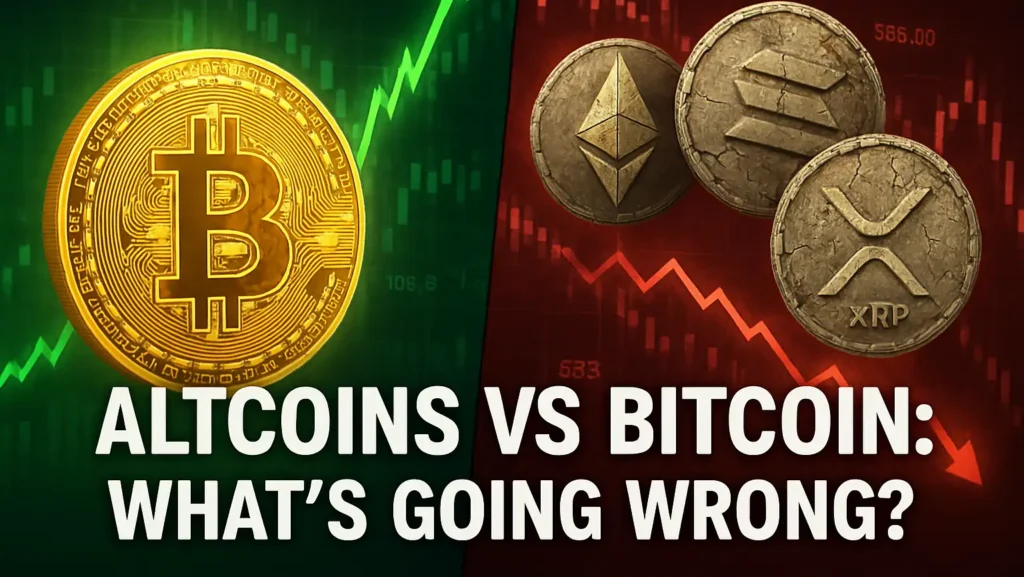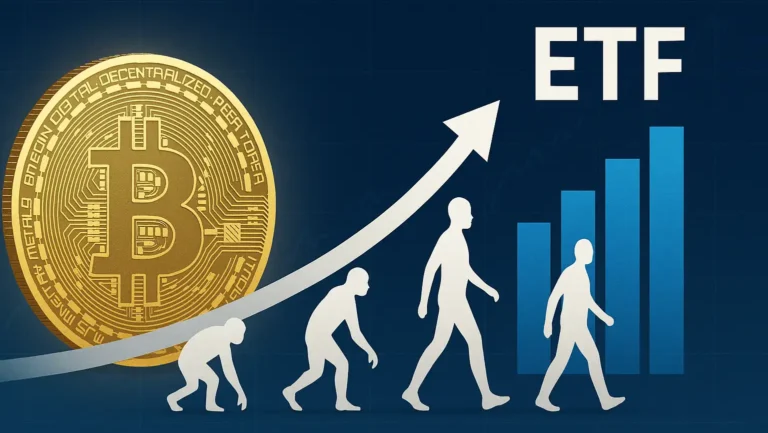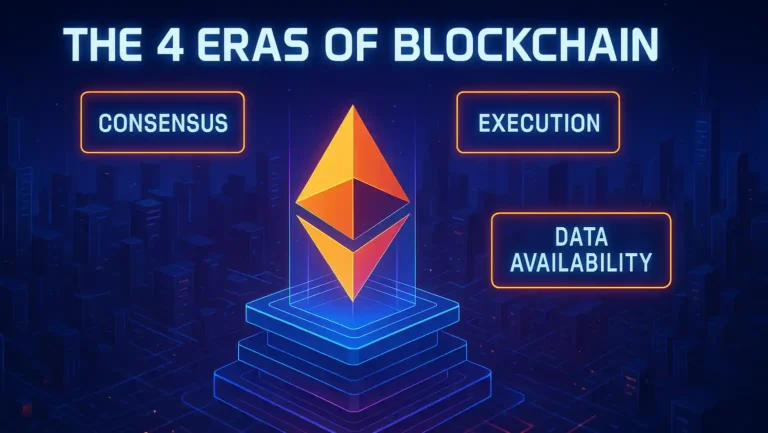Bitcoin vs Altcoins: Why Altcoins Are Declining Compared to Bitcoin 2025

Why Altcoins Are Declining Compared to Bitcoin
1- Market Sentiment in 2025
Bitcoin vs Altcoins: As of July 2025, the cryptocurrency market has shown a clear divergence: Bitcoin is consolidating its dominance while most altcoins are struggling to keep up.
While the total crypto market cap has crossed $4 trillion, the vast majority of that value is being absorbed by Bitcoin. Investors, analysts, and retail traders are witnessing a return to Bitcoin-led sentiment, reminiscent of earlier cycles.
For new investors entering the space, it is crucial to understand why altcoins are declining compared to Bitcoin and how this trend may evolve in the coming months. This article breaks down real-time data, institutional behavior, regulatory developments, and long-term trends to provide a holistic view.
Read: What Is Going On With Crypto Today
2. Bitcoin’s Strength and Market Position
Bitcoin is currently trading around $118,000, slightly down from recent highs near $123,000. Despite minor corrections, its dominance index remains above 60%, a clear indicator of investor trust and capital consolidation around Bitcoin.
Factors contributing to Bitcoin’s strong position:
- Approval and growth of spot Bitcoin ETFs in major markets.
- Widespread institutional adoption.
- Perception as a “digital gold” in times of economic uncertainty.
- Clear regulatory status as a digital commodity in countries like the U.S., Japan, and Germany.
3. The Weakening of Altcoins
While Bitcoin remains strong, altcoins have seen limited upside. Ethereum is hovering around $3,560 with high volatility, while others like XRP and Solana have struggled to maintain recent gains. Many altcoins have declined in BTC terms, meaning they are losing value relative to Bitcoin.
Altcoins are facing pressure in multiple dimensions:
- Shrinking liquidity
- Exchange delistings
- Lack of retail participation
- Weak narrative cycles (DeFi, NFT, memecoins)
4. Key Reasons Behind Altcoins’ Underperformance
1- Institutional Preference for Bitcoin
Institutions are pouring billions into Bitcoin ETFs, while altcoins lack similar financial products. This shift of capital is reducing altcoin liquidity and pushing BTC dominance even higher.
2- Regulatory Pressure
Many altcoins are under legal scrutiny. The U.S. SEC has classified several as securities. XRP, ADA, and SOL have been involved in lawsuits or threatened with exchange bans. In contrast, Bitcoin is not considered a security, making it the safer choice.
3- Risk-Off Macro Environment
Global uncertainty, inflationary pressure, and higher interest rates have led investors to reduce exposure to speculative assets. Bitcoin is now seen as a defensive asset, while altcoins are considered high-risk.
4 Halving Cycle Dynamics
Historically, Bitcoin rallies after each halving (last occurred in April 2024), and altcoins follow months later. We are still in the early post-halving phase where BTC tends to lead.
5 – Declining Retail Activity
Retail traders who once drove altcoin rallies are less active. Without retail hype and volume, altcoins are failing to find momentum.
5. Detailed Look at Major Altcoins (ETH, XRP, SOL)
Ethereum (ETH)
Ethereum has seen inflows due to optimism around stablecoin regulation and infrastructure upgrades. However, it remains volatile and has not kept pace with Bitcoin’s percentage growth. Ethereum ETFs are in discussion but not yet approved.
Ripple (XRP)
Despite legal clarity from past court victories, XRP continues to trade sideways. Investor trust has not fully returned due to ongoing regulatory overhangs.
Solana (SOL)
Solana showed strong recovery in early 2025 due to memecoin activity and growing DeFi usage. Still, lack of large scale institutional support has kept it from sustaining momentum.
Read: Best TradingView Indicators: Top Tools for Technical Analysis in 2025
6. The Role of Institutional Investors
Institutional behavior has dramatically shifted crypto dynamics. With the introduction of regulated products like spot ETFs, pension funds and asset managers are allocating billions to Bitcoin, pushing its price and dominance higher.
Altcoins are largely excluded from these products due to regulatory ambiguity. This institutional bias significantly influences market performance.
7. Regulatory Impact on Altcoins
2025 has been a pivotal year for crypto regulation. The passing of the GENIUS Act in the U.S. brought regulatory clarity, but mostly for Bitcoin and stablecoins. Altcoins remain in a grey area.
Consequences include:
- Delistings from centralized exchanges
- Hesitation from traditional investors
- Lawsuits and cease-and-desist orders
Bitcoin’s clean regulatory slate continues to be its biggest asset in contrast.
8. Possibility of an Upcoming Altcoin Season
Historically, an “altcoin season” begins when BTC stabilizes or consolidates. Key indicators to watch:
- Bitcoin dominance index falling below 50%
- Surge in altcoin trading volumes
- New narrative cycles (Example-, AI tokens, Web3 apps, Layer-2 innovations)
While we are not in an altseason yet, trends can shift quickly. Keep monitoring real-time charts and market sentiment.
9. Investment Strategy for Current Market
If you’re investing in 2025’s crypto environment, consider these portfolio strategies:
- Conservative Portfolio: 80% BTC, 20% ETH or stablecoins.
- Balanced Portfolio: 60% BTC, 20% ETH, 20% top altcoins with clear use cases.
- Aggressive Portfolio: 50% BTC, 20% ETH, 30% high-risk altcoins (with tight risk control).
Conclusion
Bitcoin continues to lead the market in 2025, both in terms of price performance and institutional adoption. Altcoins are facing structural headwinds including regulatory concerns, lack of retail participation, and weaker liquidity.
However, markets are dynamic. Altcoins may rebound once legal clarity improves and new narratives emerge. For now, investors should approach altcoin investments with caution, focusing on high-quality projects with proven ecosystems.
Faqs
Why are altcoins underperforming compared to Bitcoin in 2025?
Altcoins are underperforming due to several reasons, including increased Bitcoin dominance, lack of institutional support, regulatory uncertainty, and reduced retail trading activity. In contrast, Bitcoin is benefiting from ETF inflows and clear legal status in major markets.
What is Bitcoin dominance and how does it affect altcoins?
Bitcoin dominance refers to Bitcoin’s market share compared to the total crypto market capitalization. When dominance rises, it usually indicates that investors prefer Bitcoin over altcoins, which often leads to underperformance across most altcoins.
Will there be another altcoin season in 2025?
An altcoin season is possible but hasn’t begun yet. For an altcoin rally to happen, Bitcoin needs to stabilize, and altcoins need strong narratives or regulatory clarity. Keep an eye on the BTC dominance index and altcoin trading volumes as early indicators.
Should I invest in altcoins now or stick with Bitcoin?
In the current market, a conservative approach would prioritize Bitcoin due to its stability and institutional support. Altcoin investments should be made selectively, focusing on projects with strong fundamentals and clear legal standing.
How do regulations affect altcoin prices?
Many altcoins are under scrutiny from regulators like the U.S. SEC, which considers several of them to be securities. This leads to exchange delistings, limited investor access, and price volatility. Bitcoin is not affected in the same way because it’s legally treated as a commodity.
What is the impact of Bitcoin ETFs on altcoins?
Spot Bitcoin ETFs have attracted significant institutional investment, increasing Bitcoin’s dominance. Since altcoins do not have similar regulated investment products, they miss out on the same level of institutional capital inflows.
Contents
- 1 Why Altcoins Are Declining Compared to Bitcoin
- 1.1 1- Market Sentiment in 2025
- 1.2 2. Bitcoin’s Strength and Market Position
- 1.3 3. The Weakening of Altcoins
- 1.4 4. Key Reasons Behind Altcoins’ Underperformance
- 1.5 5. Detailed Look at Major Altcoins (ETH, XRP, SOL)
- 1.6 6. The Role of Institutional Investors
- 1.7 7. Regulatory Impact on Altcoins
- 1.8 8. Possibility of an Upcoming Altcoin Season
- 1.9 9. Investment Strategy for Current Market
- 2 Conclusion
- 3 Faqs
- 3.1 Why are altcoins underperforming compared to Bitcoin in 2025?
- 3.2 What is Bitcoin dominance and how does it affect altcoins?
- 3.3 Will there be another altcoin season in 2025?
- 3.4 Should I invest in altcoins now or stick with Bitcoin?
- 3.5 How do regulations affect altcoin prices?
- 3.6 What is the impact of Bitcoin ETFs on altcoins?






